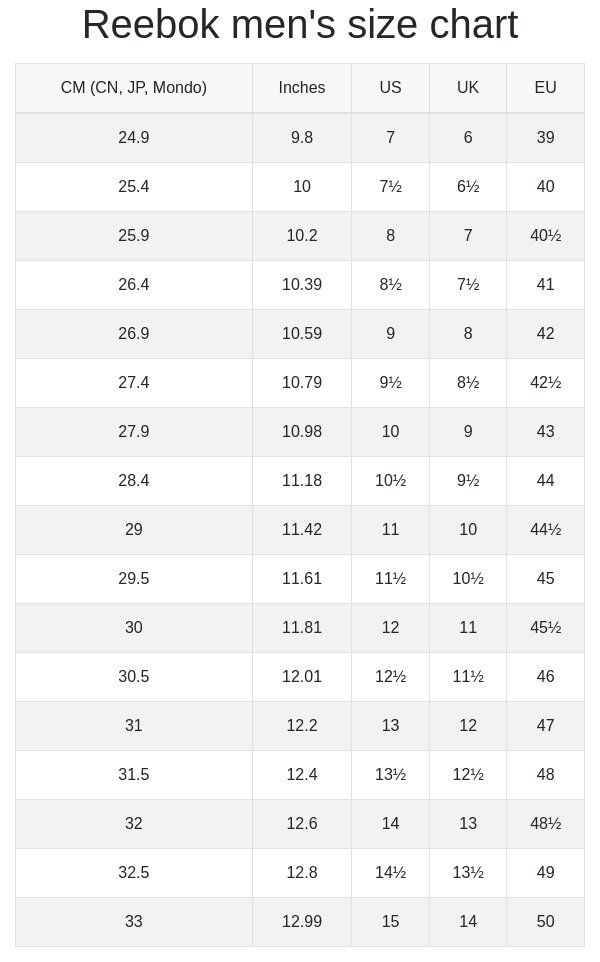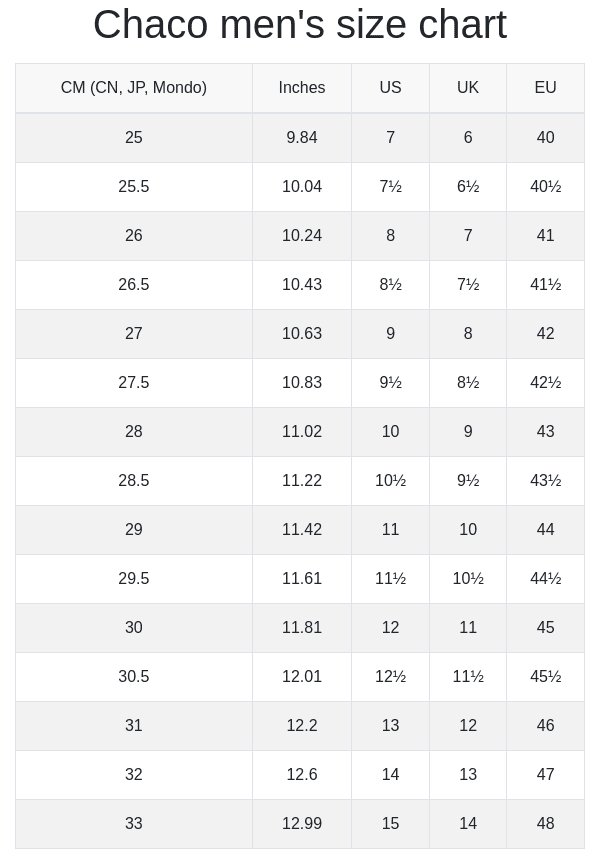Looking to upgrade your athletic wardrobe? Wondering how Reebok sizes compare to Nike? Well, you’ve come to the right place! Whether you’re a seasoned athlete or just starting your fitness journey, finding the perfect fit is crucial to your comfort and performance. In this article, we’ll delve into the differences between Reebok and Nike sizing, helping you make informed choices when it comes to your sportswear purchases. So, let’s dive right in and explore the world of Reebok sizes compared to Nike!
Reebok Sizes Compared to Nike
Understanding the Differences in Sizing
When it comes to buying athletic shoes, one of the most important factors to consider is the right size. Not all shoe brands follow the same sizing standards, and this can make it challenging to find the perfect fit. In this article, we will explore the differences between Reebok and Nike shoe sizes, helping you make an informed decision when purchasing your next pair of sneakers.
The Influence of Brand on Sizing
While both Reebok and Nike are well-known and reputable athletic shoe brands, they approach sizing in slightly different ways. It’s essential to understand these distinctions to ensure you select the appropriate size for your feet. Let’s take a closer look at each brand’s sizing practices.
Reebok Sizing
Reebok shoes are generally known for their comfortable fit and true-to-size nature. Reebok follows a standard sizing system, typically consistent with your regular shoe size. If you usually wear a size 9 in other shoe brands, you can feel confident choosing a size 9 in Reebok as well.
However, it’s important to note that Reebok offers a wide range of shoe models, each designed for different activities and foot types. Some models, like Reebok CrossFit shoes, may have a more snug fit to provide better support during intense workouts. It is advisable to read customer reviews or consult the brand’s size chart to determine if a specific Reebok model runs true to size or requires sizing up or down.
Nike Sizing
Unlike Reebok, Nike shoes tend to have a slightly different sizing approach. Many Nike models are known to run slightly smaller, especially in the width, compared to other shoe brands. It is recommended to go up half a size or even a full size when purchasing Nike shoes, especially if you have wider feet. For example, if you normally wear a size 9, it might be beneficial to try a size 9.5 or 10 in Nike.
Additionally, Nike offers various shoe collections designed for specific sports or activities. These collections, such as Nike Air Max or Nike Zoom, may have their own unique sizing characteristics. Be sure to consider these factors when selecting a Nike shoe model to ensure the best fit.
Factors to Consider When Choosing the Right Size
While understanding the differences in sizing between Reebok and Nike is valuable, it is important to remember that individual factors can influence the fit of a shoe. Everyone’s feet are unique, and various aspects should be considered when selecting the right size. Here are some essential factors to keep in mind:
Foot Shape and Arch Type
The shape of your feet and your arch type play a significant role in the fit of a shoe. Some people have wider feet, while others have narrower feet. Additionally, individuals with high arches or flat feet may require specific shoe features or sizing adjustments. Understanding your foot shape and arch type will help you choose a shoe that provides the necessary support and comfort.
Activity Level
Consider the activities you plan to engage in while wearing your athletic shoes. If you are an avid runner or participate in high-impact sports, you may prefer a snugger fit and additional support. On the other hand, if you mainly use your shoes for casual outings or low-intensity workouts, a more relaxed fit might be more comfortable.
Trying on Multiple Sizes
While online shopping is convenient, it may not always guarantee a perfect fit. If you are unsure about the sizing or are between sizes, it can be helpful to try on multiple sizes at a brick-and-mortar store. Testing various sizes will provide valuable feedback on which size feels the most comfortable and suits your needs.
Tips for Ensuring the Right Fit
To ensure you find your perfect fit, here are a few additional tips to consider:
Check the Brand’s Size Chart
Each brand usually provides a size chart on their website, giving you specific measurements for each shoe size. Comparing your foot measurements with the brand’s size chart can help you determine the most accurate size to select.
Read Customer Reviews
Online marketplaces and retailer websites often include customer reviews. Take the time to read through these reviews, paying particular attention to any comments about sizing. Previous customers’ experiences can provide valuable insights and help you make a more informed decision.
Understand Return Policies
Even with careful consideration, there may be instances where the selected size doesn’t fit perfectly. Familiarize yourself with the brand or retailer’s return policies, ensuring you have the flexibility to exchange or return your purchase in case it doesn’t meet your expectations.
Consult a Professional
If you have specific foot conditions or concerns, it may be beneficial to seek advice from a podiatrist or shoe fitting specialist. These professionals can offer personalized recommendations based on your unique needs and ensure you find the right size and style of shoes.
Finding the Perfect Fit
When it comes to choosing between Reebok and Nike shoe sizes, understanding the brand’s sizing practices and your individual requirements is crucial. While Reebok generally offers true-to-size fits, Nike shoes tend to run slightly smaller. Remember to consider factors such as foot shape, arch type, and activity level, and don’t hesitate to try on multiple sizes or seek professional guidance if needed. By incorporating these tips into your shoe shopping journey, you can increase the likelihood of finding the perfect fit and enjoy optimal comfort during your workouts and everyday activities.
Nike vs Reebok | Rivalry of the Shoe Brands
Frequently Asked Questions
What is the difference between Reebok and Nike shoe sizes?
While both Reebok and Nike provide shoe sizes, there can be some variations. Reebok shoes are generally known to have a more snug fit compared to Nike. This means that if you wear a size 9 in Nike, you might need to go up to a size 9.5 or even a size 10 in Reebok. It’s always recommended to refer to the specific size chart provided by each brand to ensure the best fit for your feet.
Does Reebok have wider shoe options compared to Nike?
Yes, Reebok tends to offer a wider range of shoe options, including wider widths, compared to Nike. This is particularly beneficial for individuals with wider feet or those who require a more spacious toe box. It’s important to note that not all Reebok models come in wide sizes, so it’s advisable to check the available options for the specific shoe you are interested in.
Are Reebok and Nike shoe sizes the same for children?
No, Reebok and Nike shoe sizes may not be the same for children. Children’s shoe sizes can vary between brands, so it’s essential to refer to each brand’s size chart for accurate measurements. It’s recommended to measure your child’s feet and compare them to the specific brand’s size guide to ensure the proper fit.
Are Reebok and Nike shoe sizes consistent across different countries?
While Reebok and Nike generally follow standardized sizing across countries, there can still be slight variations. It’s important to note that different regions may have different conversion charts, especially when it comes to men’s and women’s sizes. It’s advisable to refer to the specific country’s size chart provided by each brand or consult with the retailer to ensure the best fit.
Do Reebok and Nike have the same size conversion for men’s and women’s shoes?
No, Reebok and Nike do not have the exact same size conversion for men’s and women’s shoes. Both brands typically use different size scales for men and women. It’s crucial to refer to the specific size charts provided by each brand to determine the appropriate size for either men’s or women’s shoes.
Final Thoughts
Reebok sizes compared to Nike showcase small differences in fit, requiring customers to pay attention to sizing charts to ensure a proper fit. While both brands follow general shoe size standards, Reebok may run slightly larger compared to Nike. It is recommended that customers try on the shoes or refer to size guides provided by the respective brands to find the optimal fit. By understanding these subtle variations, shoppers can confidently make informed decisions when purchasing Reebok or Nike footwear.






